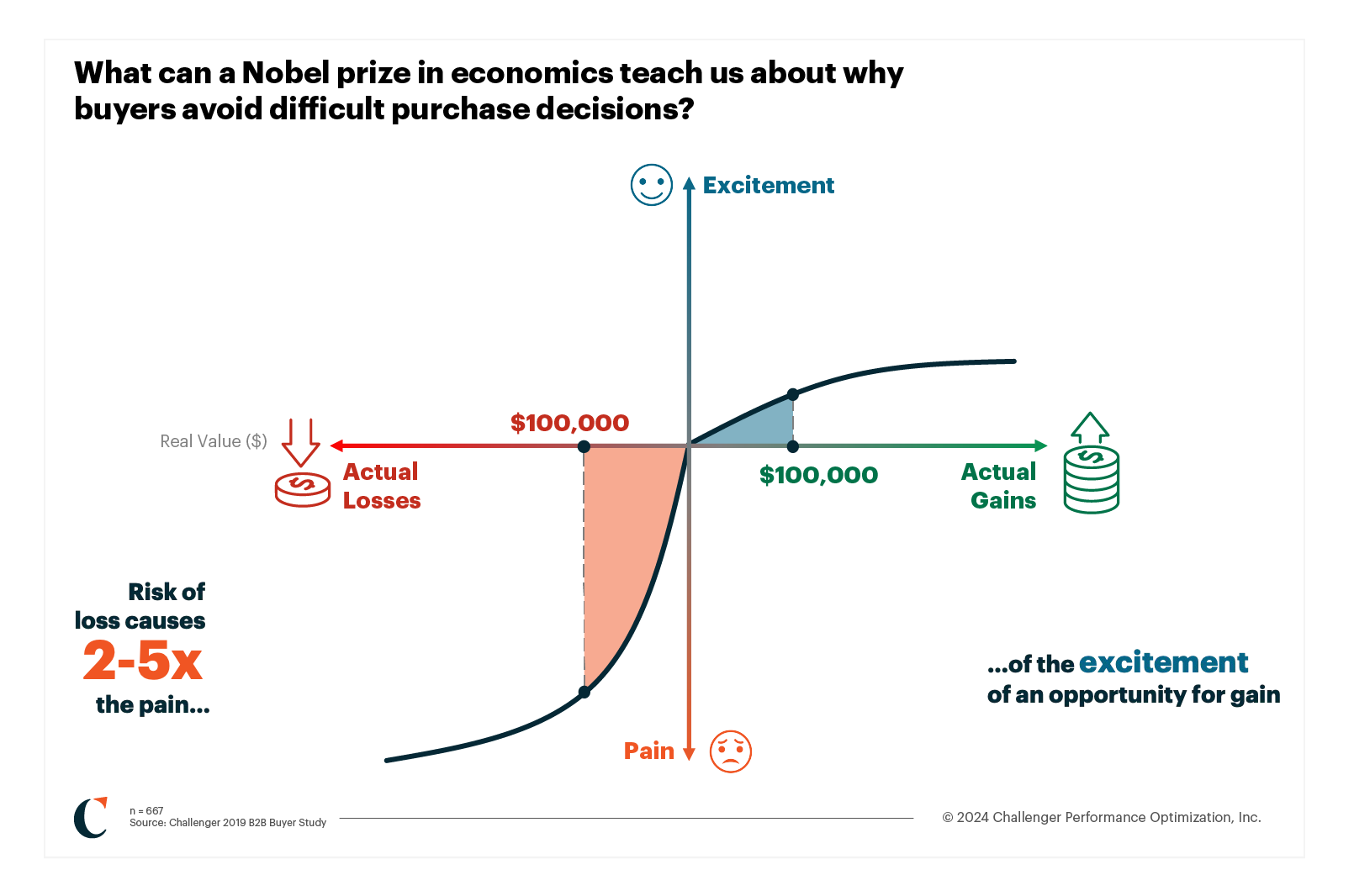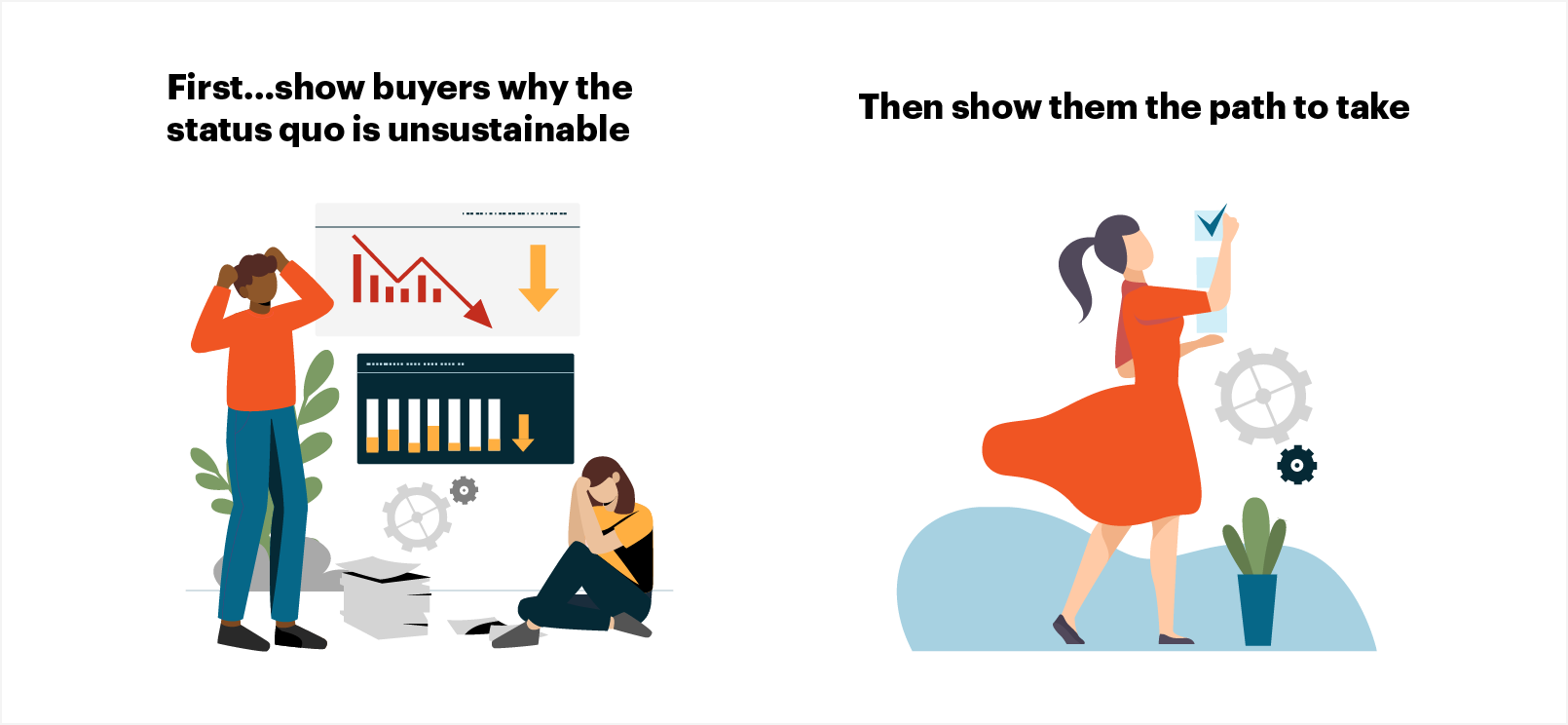Last month, I achieved a new personal best at the gym: I hip-thrusted 130kg (that’s nearly 300 lbs for our American readers). To put it into context, that’s more than 2.5 times my weight (so there you go…now you know how much I weigh). I wouldn’t have gotten this far if my conventional way of thinking hadn’t been disrupted and someone hadn’t delivered a powerful Insight that made me feel some Constructive Tension!
I know what you’re thinking: wow, you’re strong! But you’re also probably wondering, “What’s that got to do with Challenger?” We’ll get to that. But for now, let’s focus on Prospect Theory.
As humans, we want to reduce tension, keep relationships amicable, and show the benefits of doing something — what we at Challenger like to call “the gains.” The Nobel Prize-winning Prospect Theory model, developed by Kahneman and Tversky, shows that the human tendency toward reducing tension is a less effective motivator than loss aversion. Loss aversion is a cognitive bias that describes why, for individuals, the pain of losing is psychologically twice as powerful as the pleasure of gaining. In short, the pain of losing money (or any other valuable item) is more significant than the pleasure of gaining an equal amount.

Or as John Legend recently put it:
When you prepare for a conversation with a prospect or client aimed at changing their current way of working, it is imperative that you include the negative consequences of sticking to the status quo. This is what I tell my clients every day, and yet it remains a difficult concept for many sellers. Companies then exacerbate this problem by ignoring Prospect Theory entirely and spending a lot of time teaching reps how to sell the company’s products and solutions rather than understanding customers’ problems and identifying solutions. For this reason, training and ongoing reinforcement is key. Irrespective of the industry, country, or region that your organization operates in , research shows that delivering a sales experience that challenges the status quo and helps the customer think differently will win more business.
But let me take a step back and remind you that I’m currently hip-thrusting 130kg. And to get to this achievement, I experienced firsthand what I tell my clients every day…
It all started a year ago: I grew tired of my workout routine and wanted to increase my strength as I felt I had plateaued. I am not new to strength training and nutrition, but I was eager for a new perspective – I read articles, watched videos, tried different exercises, and still felt stagnated. I have always been reluctant to spend money on a personal trainer ; but was willing to talk to some and see if it was worth it.
I did my research and narrowed down the three I wanted to talk to that specialized in strength building. All of them asked me the same questions: my goals, my current routine and lifestyle, my eating habits. I had some nice conversations and gained a few tips; but ultimately, they proved to me that my status quo was good enough and that with some tweaks, I could continue building strength. I didn’t choose any of them. One might say I chose nothing over something (like 40-60% of B2B buyers these days).
One key learning of Prospect Theory is that when people are presented with opportunities for gain, it naturally triggers risk aversion. For me, when the trainers made their positive suggestions, to be honest I was automatically triggered to be risk averse — and do nothing — as many buyers often do.
Then one day a new trainer approached me. I nearly told her, “no thanks”, but before I could, she said “I noticed you have abdominal separation like many of my female clients. They often have it from pregnancy. Is that the case with you?” No PT had ever spotted this, much less pointed it out so boldly. I felt a little self-conscious, even defensive. We started chatting, and she shared with me something I was completely unaware of about my current trajectory: If I continued to do heavy lifting as I was, I would weaken my core, my back would suffer, and eventually I could severely injure myself, therefore taking me away of exercise for a while. Clearly this would prevent me from achieving my goals. She shared a story of how it happened to herself as a new mother, painting a picture I could use as a frame of reference and lending power to her case for change. And then she shared that strength gaining with abdominal separation was her speciality.
That trainer perfectly executed the Challenger choreography, and I perfectly executed a buyers’ journey and committed to six months of personal training and to achieve my goal. In essence, she delivered a Commercial Insight by:
- Considering her customers’ status quo and highlighting what the gap was – in this case, a literal abdominal one! (Warmer and Reframe)
- Intensifying the consequences by showing the cost of staying the same and humanizing the problem with storytelling (Rational Drowning and Emotional Impact)
- Identifying a new approach that was unique to her solution (New Way and Your Solution).
She helped me avoid loss — and mitigated my fears — to lead me out of decision by indecision.

At Challenger, we support organizations in refining their go-to-market strategy by helping them build the right message, for the right stakeholders, at the right time. We can’t promise you gym gains like mine — but we can show you how to use Prospect Theory, Reframes, and the Challenger choreography to show your customers a new way and your solution.
If you’d like to discuss how to develop commercial insights that disrupt the status quo for your customers, get in touch!
Veronica Coli
Veronica is Challenger's Sr. Director of Client Success. She is based in London and loves leading tailored implementation journeys with our most strategic accounts, seeing customer results, and sharing learnings across cultures and regions.
More from our blog
Challenger’s guide to sales transformation
Key takeaways Challenger’s approach to driving predictable revenue and sustainable growth is known as commercial transformation Transformation goes…
Strengthen Your Coaching Skills with Challenger’s PAUSE Framework
There’s only one seller productivity investment endorsed as more important than all others by Matt Dixon and Brent Adamson, authors of “The…
Richardson and Challenger named a Top 20 Sales Training Company
Richardson and Challenger celebrate its selection today as one of Training Industry’s 2025 Top 20 Training Companies™ for the Sales Training and…
What are you waiting for?
Transform your sales team.
The best companies grow, and grow fast, by challenging customers, not by serving them.




